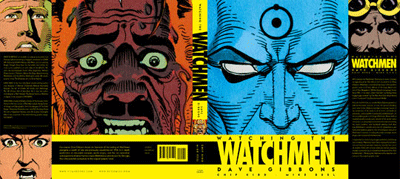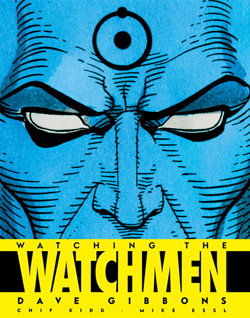I’ve been keeping my eye out for Watching the Watchmen since Comic Con, when I attended a panel given by the three creators behind this book: author Dave Gibbons (the artist on Watchmen, in case you’ve been living under a rock), designer Mike Essl, and art director Chip Kidd (who admittedly took a back seat role to Essl, due to conflicts with his other new book, Bat-Manga!). Ever since, I’ve been waiting patiently and paying close attention to Mike Essl’s Twitter feed, as he neared completion of the project and sent it to the printers.
Before attending the panel, I was skeptical of how the book would play out, and how it would stack up against the Absolute edition of Watchmen. After the panel, I was optimistic. Last Friday, when Irene walked into the office after a low-blood-sugar-inspired book-buying binge with her copy in tow, I quickly confiscated it. After all, she hadn’t finished Watchmen proper—no dessert until you’re done with supper, I say.
So I got to spend Sunday afternoon with Dave Gibbons and Mike Essl, as they took me on a trip into the creative and production process behind one of the most important works in comics history.
And it’s an important distinction to make, because as much as the book does touch upon the ideas that went into Watchmen, it’s much more a chronicle of the creative process behind the book from the artist’s perspective. Narrated by Dave Gibbons, Watching the Watchmen reads like a very dense production journal, where the creator has kept every scrap of conceptual material he ever generated.

Each chapter in the book addresses a chapter in Watchmen, in addition to a few chapters dealing with initial reactions to the release of the first few issues, some random acts of weirdness related to some of the artwork, and a large chunk devoted to John Higgins’ color work, whose praises Gibbons never seems to stop singing (and rightly so: colorists are largely overlooked in comics, and Watchmen was fortunate to have Higgins on board, and doubly fortunate to enjoy a full re-mastering by Higgins for the Absolute edition). Higgins is also brought in to write a bit about the coloring process, and his role in the development of the series. His insight into the printing process, and the limitations of the state of the art at the time and how he got around them (or didn’t) lead nicely into his evident enthusiasm when talking about the re-coloring job he did for the Absolute edition, with the help of Wildstorm studios.
While Gibbons hasn’t kept any of the original art from Watchmen (there’s a good anecdote explaining why towards the end of the book), he does still have almost every page thumbnail, many layout guides, and plenty of development material. The thumbnails are particularly striking—Essl has laid out each chapter with as many thumbnails as he could find, in chronological order, occasionally juxtaposing them with the finished artwork—the level of fidelity from thumbnail to finished page is amazing, and prompted me to pull out my copy of Watchmen to compare, panel by panel, the thumbnails to each page of the book.
Aside from the prerequisite preliminary sketches depicting alternate costumes for the main characters, color studies for the covers, and such material as is now familiar to those who enjoy looking at comics artists’ sketchbooks, Gibbons also includes plenty of work that was never intended to do anything other than keep his visual storytelling consistent and cohesive, and this is the stuff I find the most compelling. Included throughout Watching the Watchmen are development schematics for major set pieces in the story, such as the intersection where the Gunga Diner and the newsstand are located, and the exact layout of the final, apocalyptic scene. Also, smaller pieces of reference, such as a grid guide to keep the repeated motif of Jon Osterman’s pre-Dr. Manhattan picture with his first sweetheart consistent from issue to issue; the layout and camera movements through Moloch’s apartment; and, most impressive of all, a motion guide for the poetic moment when a bottle of perfume goes hurtling through the martian atmosphere. As Gibbons notes, this sketch in particular, and the series of panels it informed, could have been slit up and turned into a flip-book, it’s so detailed and consistent.
The book closes with a sampling of ephemera, and a short recounting of how the Absolute edition came to be, further reinforcing the sense that this is truly a companion piece to that beautiful tome, rather than a re-hashing of stuff seen before. As a fan, and a completist, both books deserve a place next to each other on my bookshelf—they complement each other perfectly (yes, yes, Irene, I’ll bring your copy back and get my own).










